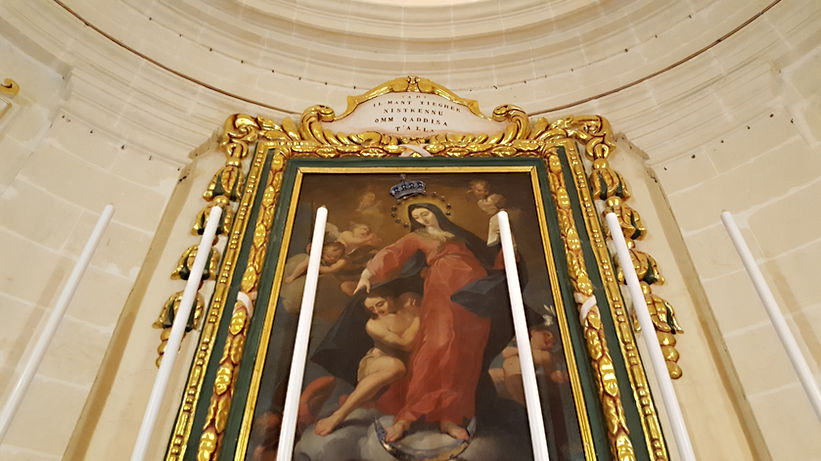
Basilica of
The Patronage of Our Lady
Gozo's first Basilica

The Basilica of the Patronage of Our Lady, situated in the geographical heart of the village of Għasri, namely, Wied l-Għasri Valley forms part of our parish. Our historic basilica, also known as the 'Bażilka tal-Wied', holds a rich history and significant religious importance. The following is a summary of its origins, features, and devotion.
Origins and Significance: Dating back to the early 16th century, our basilica's roots can be traced to a humble chapel dedicated to the Virgin Mary under the title of the Assumption. Originally built by the Cini family, it became a place of deep devotion and consecration over the years. The church's history intertwines with the papal blessings of various popes, elevating it to the esteemed status of a Minor Basilica.
Devotion and Community: The Basilica of Our Lady of the Patronage is not just a place of worship; it's a center of Marian devotion and community. In addition to the parish church at Għasri's Square, the parish has been instrumental in nurturing this devotion and overseeing restoration projects. Sunday Masses are held all year, allowing worshippers to experience the solemnity and spiritual connection our basilica offers.
Feast date: Second Sunday of October. The Feast of the Patronage of the Virgin Mary is first found in Spain, where, at the request of King Philip IV, Pope Alexander VII, by decree on the 28th of July, 1656, wanted it to be celebrated on the Sunday after the Feast of All Saints as a thanksgiving to Our Lady for her protection over the country throughout the ages. In 1679, the feast began to be celebrated in all the lands under Spanish rule, and in the 18th century, it spread to Italy, from where it came to our country. In Gozo, at Wied l-Għasri, between 1737 and 1739, a chapel was built dedicated to the Patronage of Our Lady: this chapel was rebuilt in 1754 and was consecrated by Bishop Labini. This chapel was granted the title of Basilica (the first one in Gozo) and was affiliated with Santa Maria Maggiore.

Masses: Every Sunday
5pm (Winter)
6pm (Summer)
and in Marian Wednesdays

Gozo’s First Basilica
Thanks to the efforts of Fra Angelo Bonnici, a friend of Dun Tumas, the church was officially aggregated to the papal Basilica of St. Mary Major in Rome. A decree from 1768 granted it the prestigious title of minor basilica, making it Gozo’s oldest. Originally, the church and the surrounding village of Għasri fell under the jurisdiction of Żebbuġ but separated in 1739. It was consecrated by Bishop Vincenzo Labini in 1789, and for 161 years, it remained the only consecrated countryside church.
Works of Art
The church houses several artistic treasures, including a titular painting attributed to Francesco Zahra, depicting the Virgin Mary protecting a figure from Satan. The main altar, made of honey-coloured Gozitan alabaster, was blessed in 1789. Other notable works include a painting of Christ’s descent from the Cross, two additional altars dedicated to St. Paul and St. Joseph, and a collection of paintings and silver lamps.
Architecture
The church’s façade resembles that of St. Publius in the same area, featuring pilasters rising to an entablature with a triangular pediment above. A central oval window allows light to filter inside, and the building is crowned with an unusual dome lacking a lantern. The interior, with a Baroque touch, is similarly simple yet elegant, while the exterior boasts a spacious parvis and vestry.
History
It is interesting to note that in 1768, the Vatican granted it the title of minor basilica, making it the oldest basilica in Gozo and the third oldest in Malta. Over the centuries, several chapels have stood on this site. As early as the 16th century, a chapel here already served as the main Christian place of worship for the Tal-Wied area. The first chapel dates back to 1530. In the Middle Ages, a small village surrounded the church. The present church is the third one built on this site and dates to 1750. The cornerstone of the current church was laid on 16 September 1737, and the church was blessed on 8 May 1739. It was later expanded to meet the growing demand, and was blessed again on 5 October 1754 after the completion of the works.


















